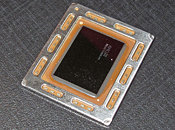- Joined
- Oct 9, 2007
- Messages
- 47,371 (7.52/day)
- Location
- Hyderabad, India
| System Name | RBMK-1000 |
|---|---|
| Processor | AMD Ryzen 7 5700G |
| Motherboard | ASUS ROG Strix B450-E Gaming |
| Cooling | DeepCool Gammax L240 V2 |
| Memory | 2x 8GB G.Skill Sniper X |
| Video Card(s) | Palit GeForce RTX 2080 SUPER GameRock |
| Storage | Western Digital Black NVMe 512GB |
| Display(s) | BenQ 1440p 60 Hz 27-inch |
| Case | Corsair Carbide 100R |
| Audio Device(s) | ASUS SupremeFX S1220A |
| Power Supply | Cooler Master MWE Gold 650W |
| Mouse | ASUS ROG Strix Impact |
| Keyboard | Gamdias Hermes E2 |
| Software | Windows 11 Pro |
AMD's next-generation accelerated processing unit (APU), codenamed "Trinity", was demonstrated at CES. Trinity will make up AMD's 2012 A-Series APU lineup, and will be designed for mainstream-thru-performance notebooks, and mainstream desktops (different standards for different form-factors). Pictured below is what its notebook-specific BGA package looks like. The package has an exposed rectangular die, with a stabilizer frame around it (like with GPUs). Notebooks' cooling assembly heat pipes make direct contact with the die. Trinity packs two Piledriver modules (an evolution of Bulldozer), and DirectX 11.1 AMD Radeon HD 7000M graphics (notebook APU) or HD 7000D (desktop APU).
Shown to the CES crowd was a mind-boggling demo. The public were first shown what appeared to be an ATX desktop connected to two monitors, one monitor running a DIRT 3 DirectX 11 game demo at high-quality settings, and another screeen revealing the APU to be running GPU-accelerated video transcoding. No discrete graphics was used, it's just the embedded HD 7000 at play/work. If that alone didn't raise a few eyebrows, the AMD representative removed the lid of the ATX desktop case to which those two monitors were connected, to reveal a 14-inch laptop inside doing all the work. And there's more - the laptop's main screen wasn't idle, it was running a high-definition video playback. Whatever synthetic benchmarks end up telling about Trinity, its real world performance does impress!

You have got to watch the video after the break!
At a discrete meeting with select journalists at a backroom, AMD also talked about its competitive technology to Intel's Thunderbolt, which it's referring to as "Lightning Bolt" (+1 for originality). This interface will use the same mini-DP port design as Thunderbolt. It will have the bandwidth to drive up to four HD displays, and multiple USB 3.0 devices, and will have a hub cost of under $40.
View at TechPowerUp Main Site
Shown to the CES crowd was a mind-boggling demo. The public were first shown what appeared to be an ATX desktop connected to two monitors, one monitor running a DIRT 3 DirectX 11 game demo at high-quality settings, and another screeen revealing the APU to be running GPU-accelerated video transcoding. No discrete graphics was used, it's just the embedded HD 7000 at play/work. If that alone didn't raise a few eyebrows, the AMD representative removed the lid of the ATX desktop case to which those two monitors were connected, to reveal a 14-inch laptop inside doing all the work. And there's more - the laptop's main screen wasn't idle, it was running a high-definition video playback. Whatever synthetic benchmarks end up telling about Trinity, its real world performance does impress!

You have got to watch the video after the break!
At a discrete meeting with select journalists at a backroom, AMD also talked about its competitive technology to Intel's Thunderbolt, which it's referring to as "Lightning Bolt" (+1 for originality). This interface will use the same mini-DP port design as Thunderbolt. It will have the bandwidth to drive up to four HD displays, and multiple USB 3.0 devices, and will have a hub cost of under $40.
View at TechPowerUp Main Site












